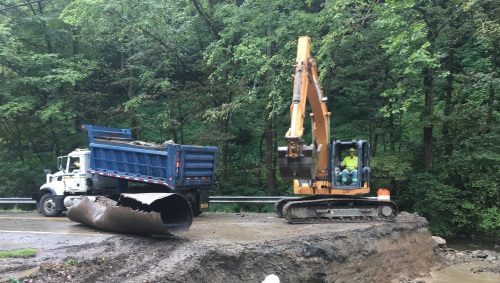ARTBA: Transportation Construction Market To Shrink In 2021

The U.S. transportation construction market should shrink by 5.5 percent in 2021 primarily due to the severe economic recession caused by the COVID-19 pandemic, according to an annual forecast released December 10 by the American Road & Transportation Builders Association.
[Above photo by the West Virginia DOT.]
Overall, the value of work should drop from $294.2 billion in 2020 to $278.1 billion in 2021, according to Alison Premo Black, ARTBA’s chief economist.

“Not surprisingly, the 2021 market [outlook] reflects the broader COVID-19 economic contraction that began in February 2020,” Black said in a statement. “Congress and the president could help mitigate the economic downturn and put the nation on the road to a stronger recovery by approving a long-term, robustly funded transportation infrastructure investment package early in 2021.”
However, Black noted that the expected market contraction in 2021 follows a “record year” for transportation construction in most sectors for 2020, as most states – barring a select few – classifying “transportation construction” as an essential industry. That classification provided a window of opportunity for many state departments of transportation to maintain, speed up, and in some cases complete work sooner than expected on a variety of projects.

As a result, total transportation construction activity – after project costs and inflation – is expected to increase by nearly 4 percent in 2020, with significant gains in highway and street construction (up 8.3 percent), subway and light rail work (up 8.8 percent), airport terminal and runway construction (up 7.2 percent), and port and waterway spending (up 12 percent), according to ARTBA.
The one exception is bridge and tunnel construction, which suffered a 20 percent drop in construction activity in 2020, reflecting several broader market trends including a focus on smaller structures, ARTBA noted.
Looking forward to 2021, the significant and cumulative drop-off in motor fuel tax revenue and other user fees due to COVID-19 stay-at-home orders initiated last spring, combined with increases in national unemployment – along with declines in public transit use and air travel demand – are the key factors affecting the outlook, the group said.
ARTBA added that states are expecting shortfalls in transportation revenues of anywhere from $35 billion to $40 billion through 2024 due to the fall-off in motor fuel tax revenues and other user fees – a decline that is forcing state DOTs to adjust everything from snow plowing strategies to rest area operation.
However, ARTBA’s Black emphasized that transportation construction growth could resume in 2022 provided that economic conditions improve and travel demand in some sectors begins to return to pre-recession levels.


